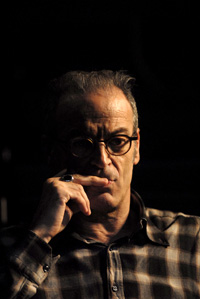Tomeo Vergés

By Irène Filiberti for L’Apostrophe scène nationale de Cergy-Pontoise, France (2012)
Short-Circuits
Tomeo Vergés’universe is a fantastical world that is at once theatrical and humorous. His company’s dancing is raw, energetic, enigmatic and beats with the deepest impulses of man, that animal graced with the spoken word. His theatrical universe is built of space and textures, or rather objects, often used in unexpected ways. Tomeo Vergés’ work is anchored in the greatest and most delicate of human passions. Passions that rule our days and illuminate our nights like a watchtower. His choreography moves between true and false, jumping over boundaries. The titles of his pieces Pièce(s) détachée(s), Body Time, Idiotas and Meurtres d’intérieur, at once convey the tone of his pieces, and provide a window onto his preoccupations.
Funny Feelings
Tomeo Vergés is appreciated not only for his dance pieces, but also for the workshops and events he leads for people of all ages and abilities. From his origins in the Catalan Pyrenees to the city where he lives and works today, Tomeo Vergés has, since founding his company Man Drake in 1992, cultivated a conception of life and dance that borrows heavily from the theater of the absurd.
Elements of his autobiography are certainly a major part of the attraction -- somewhere between fascination and disgust -- that one feels watching his most recent piece, Anatomia publica. In all of his work, Tomeo Vergés maintains a focus on the body. The strange and public evocation of the anatomy in this latest piece is due in large part to memories of his childhood : “Son of a butcher and doctor by training, I have often been in contact with meat and flesh. When I imagine my father skinning a rabbit or remember an anatomy lesson, I still feel a strange sensation come over me, a mix of attraction and repulsion.”
For the choreographer, this warehouse of memories provides an opportunity to imagine an anatomical exercise. Like a scientist he is in constant experimentation. He dissects movement with his eye; he digs, with scalpel-like precision, into gesture and movement. The body, at once a singular presence and a tool in the dancer’s box, thus passes under the microscope. In piecing apart the minute components of the body, Tomeo Vergés un-winds the mechanisms of our human clock-work, in order to better investigate the unconscious, to break down and reveal the structure that underlies a gesture.
A former professional swimmer, and MD, Tomeo Vergés was himself a dancer for many years. He has worked with numerous choreographers, including Maguy Marin (in the celebrated piece May B) and Carolyn Carlson, the influential american dancer and choreographer who lives and works in Paris, and whose teaching has had such a profound impact on Italian and French contemporary dance.
It is likely while working with Carolyn Carlson, that Tomeo Vergés crossed paths with the remarkable choreographer Caterina Sagna. These two artists ask similar questions about the role of theatricality in dance, and share a taste for humor and for satire.
Caterina Sagna’s work produces a certain expression of movement, a particular sort of fluidity and continuum, that is a perfect counterpoint to the dance Tomeo Vergés has developed in Anatomia Publica : A sort of gestural rebus, with his trademark somersaults and ruptures, his discontinuous rhythms and breakdowns and incongruous losses of control that never cease to surprise us.
Secrets of a Gesture
What constitutes our actions ? What lies under the visible surface of our acts? To examine these questions, Tomeo Vergés has been inspired by other artists and forms, notably by the experimental cinema of Martin Arnold. Known for his work with found footage, Arnold makes his images stutter, repeating them again and again, giving rhythm to each sequence until it forms its own music. In doing so, he teases out new and different interpretations, and allows for an unconscious understanding of the images. Changing the point of view is one of the key elements of this way of working, as the filmmaker, a kind of cinematographic DJ, explains : “Hollywood is a cinema of exclusion, of reduction, of refusal : a repressive cinema. There is always something behind what you see, something that is not shown. That is what is interesting to consider.”
Applying this technique to the body and to movement on stage, Tomeo Vergés questions how we see the human being and the very idea of dance. In doing so he brings together two currents that are a priori contradictory : popular culture and the spirit of the avant-garde. Anatomica publica is thus the expression of a unique form of theater : a marriage between vaudeville and the experimental.

